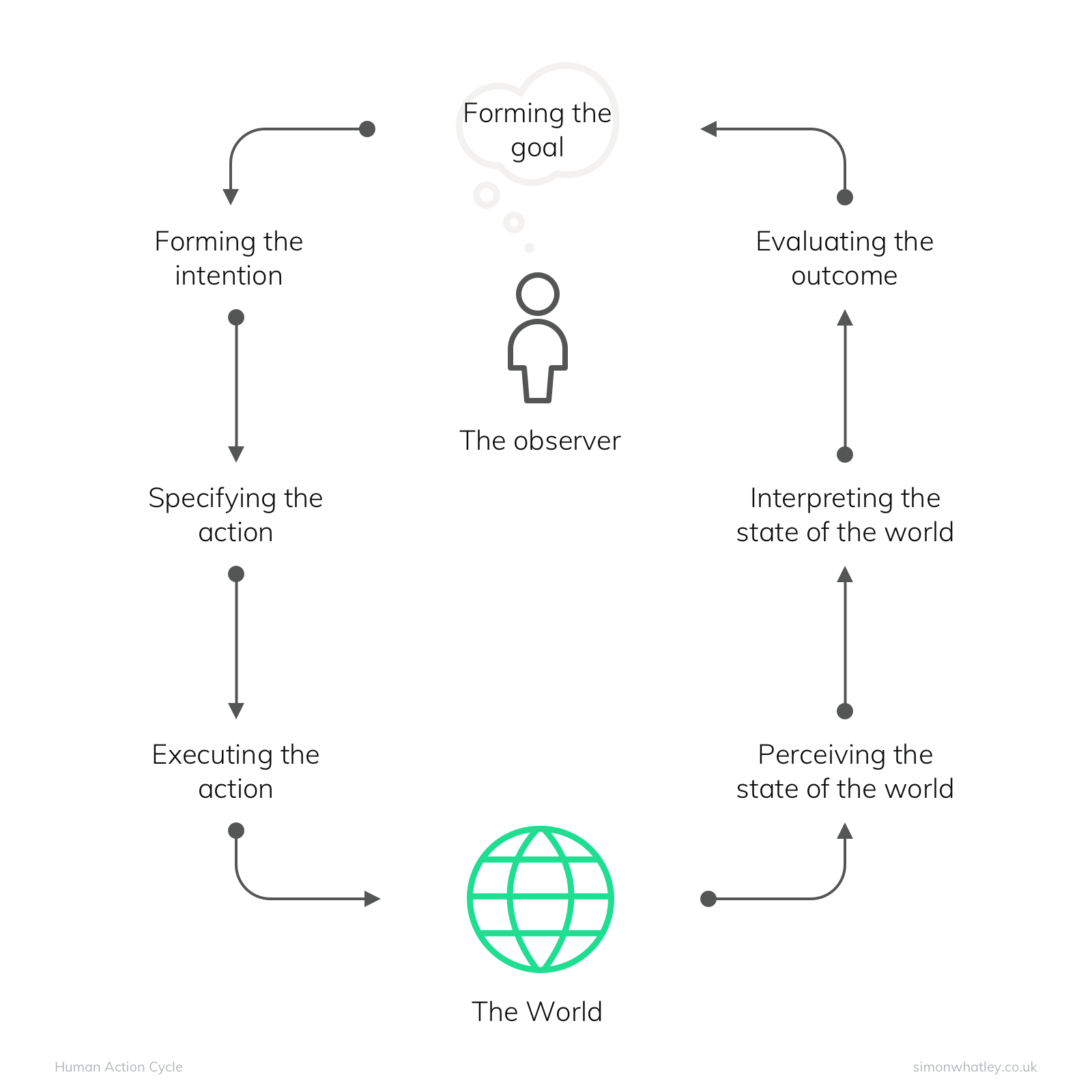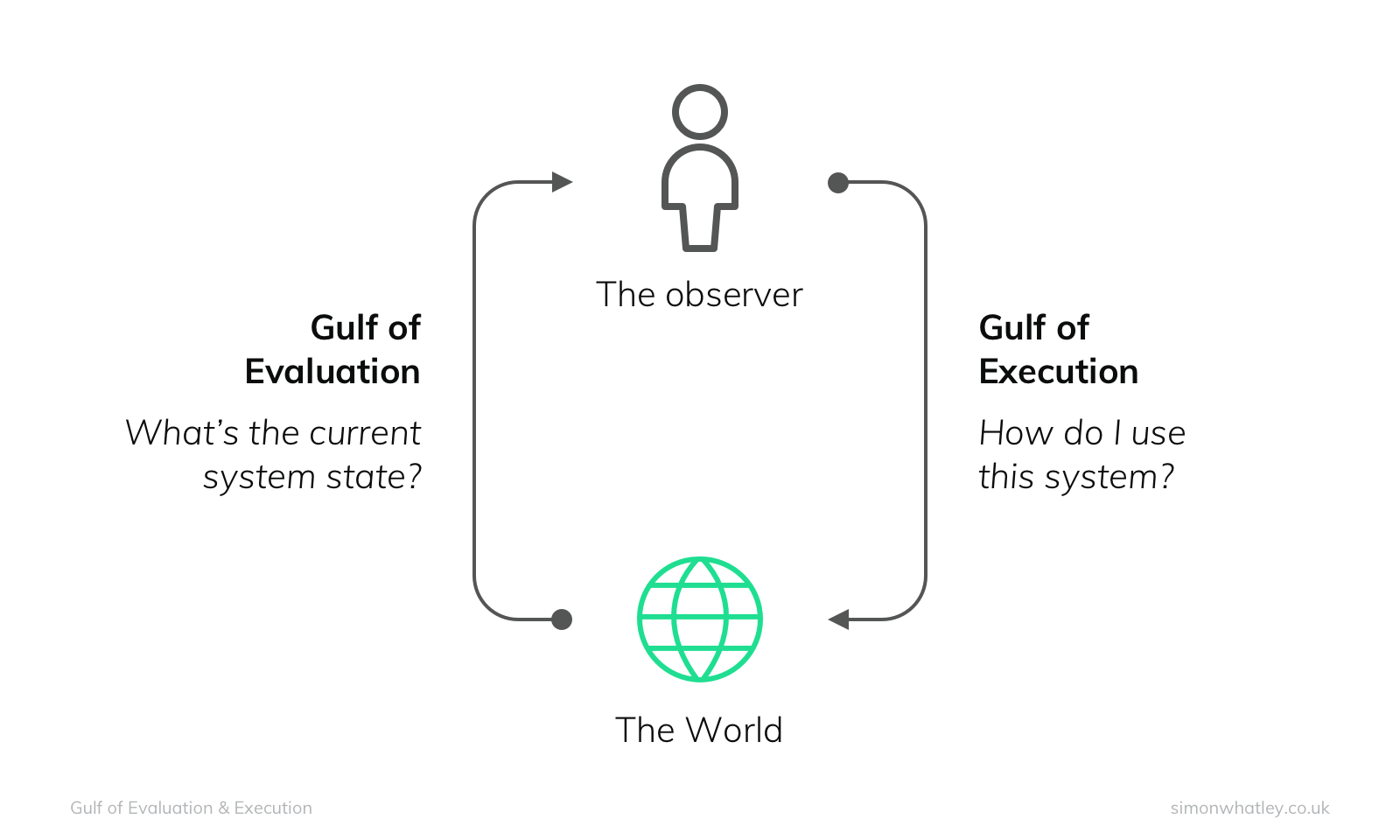The Human Action Cycle by Don Norman
This post is part of a series of notes I collated during my studies at UCL’s Interaction Centre (UCLIC).
The human action cycle, also known as the Seven Stages of Action, is a psychological model which describes the steps humans take when they interact with computer systems. The model can be used to help evaluate the efficiency of a user interface (UI). Understanding the cycle requires understanding the user interface design principles of affordance, feedback, visibility and tolerance.
- An affordance is a quality of an object, or an environment, that allows an individual to act.
- Feedback describes the situation when output from (or information about the result of) an event or phenomenon in the past will influence an occurrence or occurrences of the same event/phenomenon (or the continuation/development of the original phenomenon) in the present or future. When an event is part of a chain of cause-and-effect that forms a circuit or loop, then the event is said to “feedback” into itself.
- The design should make all needed options and materials for a given task visible without distracting the user with extraneous or redundant information. Good designs don’t overwhelm users with alternatives or confuse with unneeded information.
- The design should be flexible and tolerant, reducing the cost of mistakes and misuse by allowing undoing and redoing, while also preventing errors wherever possible by tolerating varied inputs and sequences and by interpreting all reasonable actions reasonable.
The human action cycle describes how humans may form goals and then develop a series of steps required to achieve that goal, using the computer system. The user then executes the actions, thus the model includes both cognitive activities and physical activities.
The three stages of the human action cyclePermalink to section titled The three stages of the human action cycle

Figure 1: Don Norman’s Human Action Cycle also known as the Seven Stages of Action
The model is divided into three stages of seven steps in total:
Goal formation stage
- Goal formation.
Execution stage
- Translation of goals into a set of unordered tasks required to achieve goals.
- Sequencing the tasks to create an action sequence.
- Executing the action sequence.
Evaluation stage
- Perceiving the results after having executed the action sequence.
- Interpreting the actual outcomes based on the expected outcomes.
- Comparing what happened with what the user wished to happen.
The action cycle explainedPermalink to section titled The action cycle explained
Video 1: The Action Cycle explained by Don Norman
Use in the evaluation of user interfacesPermalink to section titled Use in the evaluation of user interfaces
Typically, an evaluator of the user interface will pose a series of questions for each step. An evaluation of the answer provides useful information about where the user interface may be inadequate or unsuitable. These questions might be:
Step 1 – Forming a goal:
- Do the users have sufficient domain and task knowledge and sufficient understanding of their work to form goals?
- Does the UI help the users form these goals?
Step 2 – Translating the goal into a task or a set of tasks:
- Do the users have sufficient domain and task knowledge and sufficient understanding of their work to formulate the tasks?
- Does the UI help the users formulate these tasks?
Step 3 – Planning an action sequence:
- Do the users have sufficient domain and task knowledge and sufficient understanding of their work to formulate the action sequence?
- Does the UI help the users formulate the action sequence?
Step 4 – Executing the action sequence:
- Can typical users easily learn and use the UI?
- Do the actions provided by the system match those required by the users?
- Are the affordance and visibility of the actions good?
- Do the users have an accurate mental model of the system?
- Does the system support the development of an accurate mental model?
Step 5 – Perceiving what happened:
- Can the users perceive the system’s state?
- Does the UI provide the users with sufficient feedback about the effects of their actions?
Step 6 – Interpreting the outcome according to the users’ expectations:
- Are the users able to make sense of the feedback?
- Does the UI provide enough feedback for this interpretation?
Step 7 – Evaluating what happened against what was intended:
- Can the users compare what happened with what they were hoping to achieve?
The desired outcome for a well-designed product or service is for the user to complete the action cycle once for a single action. If the user needs to repeat the cycle multiple times for the same action, the result is frustration at best and harm at worst.
Two of the many challenges people must overcome to successfully interact with technology are:
- Evaluation: Understanding the state of the system
- Execution: Taking action to accomplish a specific goal
These challenges are described as the “gulf of evaluation” and the “gulf of execution” because, without effective design elements to support users, they can become insurmountable barriers between users and their goals.

Figure 2: The gulf of evaluation and the gulf of execution describe two major challenges that users must overcome to successfully interact with any device.
The Gulf of EvaluationPermalink to section titled The Gulf of Evaluation
The Gulf of Evaluation occurs when a user has trouble assessing the state of the system. It reflects the amount of effort that the person must exert to interpret the state of the system and to determine how well the expectations and intentions have been met. Simply put, the user is expecting feedback from an action and not receiving (at best) what they expected or (at worst) nothing at all.
Determining whether something is on or off is a classic example of the gulf of evaluation.
The Gulf of ExecutionPermalink to section titled The Gulf of Execution
The difference between a user’s intentions and the allowable actions is the Gulf of Execution.
Norman illustrates this gulf with the example of a video cassette recorder (VCR):
Let us imagine that a user would like to record a television show. They see the solution to this problem as simply pressing the ‘Record’ button. However, in reality, to record a show on a VCR, several actions must be taken:
- Press the record button.
- Specify time of recording, usually involving several steps to change the hour and minute settings.
- Select channel to record on - either by entering the channel’s number or selecting it with up/down buttons.
- Save the recording settings, perhaps by pressing an “OK” or “menu” or “enter” button.
Evaluation and execution are interdependentPermalink to section titled Evaluation and execution are interdependent
Successful execution of a task is usually dependent on the correct evaluation of the system.
Bridging the gulfs with mental modelsPermalink to section titled Bridging the gulfs with mental models
Interpreting the system state requires effort. People try to minimise effort by using mental models they hold about the world around them to understand the system.
A mental model is a representation of how something works. Mental models shape what we think and how we understand the world. They are a representation of the world, the relationships between its various parts and a person’s intuitive perception about their own acts and their consequences.
Mental models can help shape behaviour and set an approach to solving problems (similar to a personal algorithm) and doing tasks.
Designers can leverage mental models by deliberately including design elements that help users build effective mental models.
Read more about the The Two UX Gulfs: Evaluation and Execution on the Nielsen Norman Group website.
Usage as design aidsPermalink to section titled Usage as design aids
The seven-stage structure is referenced as design aid to act as a basic checklist for designers’ questions to ensure that the Gulfs of Execution and Evaluation are answered.
The Seven Stages of Action can be broken down into 4 main principles of good design:
- Visibility - By looking, the user can tell the state of the device and the alternatives for action.
- A Good Conceptual Model - The designer provides a good conceptual model for the user, with consistency in the presentation of operations and results and a coherent, consistent system image.
- Good mappings - It is possible to determine the relationships between actions and results, between the controls and their effects, and between the system state and what is visible.
- Feedback - The user receives full and continuous feedback about the results of the actions.
References and further readingPermalink to section titled References and further reading
- Hutchins, E., J., Hollan, J., & Norman, D. A. (1986). Direct Manipulation Interfaces. In A. N. Donald & S. W. Draper (Eds.), User Centered System Design: New Perspectives on Human-Computer Interaction (pp. 339-352). Mahwah, NJ: Lawrence Erlbaum Associates.
- Norman, D. (2013). The Design of Everyday Things. New York, NY: Basic Books.
- Whitenton, K. (2018). The Two UX Gulfs: Evaluation and Execution. Nielsen Norman Group (NN/g).
Updated on: 10 February 2021